Evgeny Kharlamov
What Breaks Knowledge Graph based RAG? Empirical Insights into Reasoning under Incomplete Knowledge
Aug 11, 2025Abstract:Knowledge Graph-based Retrieval-Augmented Generation (KG-RAG) is an increasingly explored approach for combining the reasoning capabilities of large language models with the structured evidence of knowledge graphs. However, current evaluation practices fall short: existing benchmarks often include questions that can be directly answered using existing triples in KG, making it unclear whether models perform reasoning or simply retrieve answers directly. Moreover, inconsistent evaluation metrics and lenient answer matching criteria further obscure meaningful comparisons. In this work, we introduce a general method for constructing benchmarks, together with an evaluation protocol, to systematically assess KG-RAG methods under knowledge incompleteness. Our empirical results show that current KG-RAG methods have limited reasoning ability under missing knowledge, often rely on internal memorization, and exhibit varying degrees of generalization depending on their design.
Predicate-Conditional Conformalized Answer Sets for Knowledge Graph Embeddings
May 22, 2025Abstract:Uncertainty quantification in Knowledge Graph Embedding (KGE) methods is crucial for ensuring the reliability of downstream applications. A recent work applies conformal prediction to KGE methods, providing uncertainty estimates by generating a set of answers that is guaranteed to include the true answer with a predefined confidence level. However, existing methods provide probabilistic guarantees averaged over a reference set of queries and answers (marginal coverage guarantee). In high-stakes applications such as medical diagnosis, a stronger guarantee is often required: the predicted sets must provide consistent coverage per query (conditional coverage guarantee). We propose CondKGCP, a novel method that approximates predicate-conditional coverage guarantees while maintaining compact prediction sets. CondKGCP merges predicates with similar vector representations and augments calibration with rank information. We prove the theoretical guarantees and demonstrate empirical effectiveness of CondKGCP by comprehensive evaluations.
Evaluating Knowledge Graph Based Retrieval Augmented Generation Methods under Knowledge Incompleteness
Apr 07, 2025Abstract:Knowledge Graph based Retrieval-Augmented Generation (KG-RAG) is a technique that enhances Large Language Model (LLM) inference in tasks like Question Answering (QA) by retrieving relevant information from knowledge graphs (KGs). However, real-world KGs are often incomplete, meaning that essential information for answering questions may be missing. Existing benchmarks do not adequately capture the impact of KG incompleteness on KG-RAG performance. In this paper, we systematically evaluate KG-RAG methods under incomplete KGs by removing triples using different methods and analyzing the resulting effects. We demonstrate that KG-RAG methods are sensitive to KG incompleteness, highlighting the need for more robust approaches in realistic settings.
ReaLitE: Enrichment of Relation Embeddings in Knowledge Graphs using Numeric Literals
Apr 01, 2025



Abstract:Most knowledge graph embedding (KGE) methods tailored for link prediction focus on the entities and relations in the graph, giving little attention to other literal values, which might encode important information. Therefore, some literal-aware KGE models attempt to either integrate numerical values into the embeddings of the entities or convert these numerics into entities during preprocessing, leading to information loss. Other methods concerned with creating relation-specific numerical features assume completeness of numerical data, which does not apply to real-world graphs. In this work, we propose ReaLitE, a novel relation-centric KGE model that dynamically aggregates and merges entities' numerical attributes with the embeddings of the connecting relations. ReaLitE is designed to complement existing conventional KGE methods while supporting multiple variations for numerical aggregations, including a learnable method. We comprehensively evaluated the proposed relation-centric embedding using several benchmarks for link prediction and node classification tasks. The results showed the superiority of ReaLitE over the state of the art in both tasks.
DAGE: DAG Query Answering via Relational Combinator with Logical Constraints
Oct 29, 2024Abstract:Predicting answers to queries over knowledge graphs is called a complex reasoning task because answering a query requires subdividing it into subqueries. Existing query embedding methods use this decomposition to compute the embedding of a query as the combination of the embedding of the subqueries. This requirement limits the answerable queries to queries having a single free variable and being decomposable, which are called tree-form queries and correspond to the $\mathcal{SROI}^-$ description logic. In this paper, we define a more general set of queries, called DAG queries and formulated in the $\mathcal{ALCOIR}$ description logic, propose a query embedding method for them, called DAGE, and a new benchmark to evaluate query embeddings on them. Given the computational graph of a DAG query, DAGE combines the possibly multiple paths between two nodes into a single path with a trainable operator that represents the intersection of relations and learns DAG-DL from tautologies. We show that it is possible to implement DAGE on top of existing query embedding methods, and we empirically measure the improvement of our method over the results of vanilla methods evaluated in tree-form queries that approximate the DAG queries of our proposed benchmark.
Predictive Multiplicity of Knowledge Graph Embeddings in Link Prediction
Aug 15, 2024

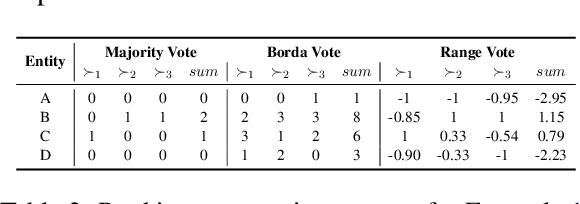

Abstract:Knowledge graph embedding (KGE) models are often used to predict missing links for knowledge graphs (KGs). However, multiple KG embeddings can perform almost equally well for link prediction yet suggest conflicting predictions for certain queries, termed \textit{predictive multiplicity} in literature. This behavior poses substantial risks for KGE-based applications in high-stake domains but has been overlooked in KGE research. In this paper, we define predictive multiplicity in link prediction. We introduce evaluation metrics and measure predictive multiplicity for representative KGE methods on commonly used benchmark datasets. Our empirical study reveals significant predictive multiplicity in link prediction, with $8\%$ to $39\%$ testing queries exhibiting conflicting predictions. To address this issue, we propose leveraging voting methods from social choice theory, significantly mitigating conflicts by $66\%$ to $78\%$ according to our experiments.
Conformalized Answer Set Prediction for Knowledge Graph Embedding
Aug 15, 2024Abstract:Knowledge graph embeddings (KGE) apply machine learning methods on knowledge graphs (KGs) to provide non-classical reasoning capabilities based on similarities and analogies. The learned KG embeddings are typically used to answer queries by ranking all potential answers, but rankings often lack a meaningful probabilistic interpretation - lower-ranked answers do not necessarily have a lower probability of being true. This limitation makes it difficult to distinguish plausible from implausible answers, posing challenges for the application of KGE methods in high-stakes domains like medicine. We address this issue by applying the theory of conformal prediction that allows generating answer sets, which contain the correct answer with probabilistic guarantees. We explain how conformal prediction can be used to generate such answer sets for link prediction tasks. Our empirical evaluation on four benchmark datasets using six representative KGE methods validates that the generated answer sets satisfy the probabilistic guarantees given by the theory of conformal prediction. We also demonstrate that the generated answer sets often have a sensible size and that the size adapts well with respect to the difficulty of the query.
Alleviating Over-Smoothing via Aggregation over Compact Manifolds
Jul 27, 2024Abstract:Graph neural networks (GNNs) have achieved significant success in various applications. Most GNNs learn the node features with information aggregation of its neighbors and feature transformation in each layer. However, the node features become indistinguishable after many layers, leading to performance deterioration: a significant limitation known as over-smoothing. Past work adopted various techniques for addressing this issue, such as normalization and skip-connection of layer-wise output. After the study, we found that the information aggregations in existing work are all contracted aggregations, with the intrinsic property that features will inevitably converge to the same single point after many layers. To this end, we propose the aggregation over compacted manifolds method (ACM) that replaces the existing information aggregation with aggregation over compact manifolds, a special type of manifold, which avoids contracted aggregations. In this work, we theoretically analyze contracted aggregation and its properties. We also provide an extensive empirical evaluation that shows ACM can effectively alleviate over-smoothing and outperforms the state-of-the-art. The code can be found in https://github.com/DongzhuoranZhou/ACM.git.
Pre-Training and Prompting for Few-Shot Node Classification on Text-Attributed Graphs
Jul 22, 2024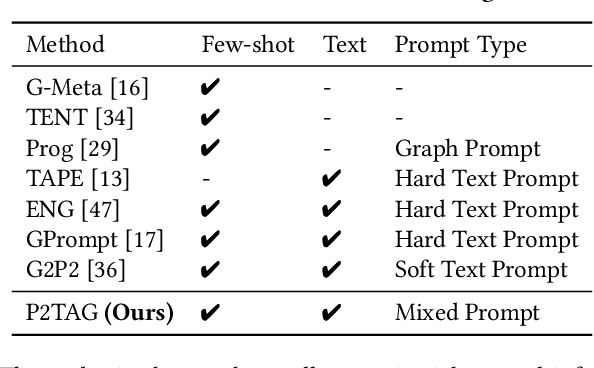
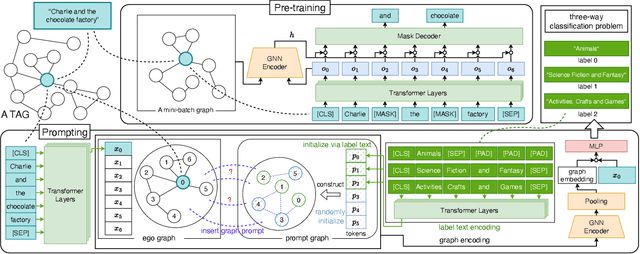
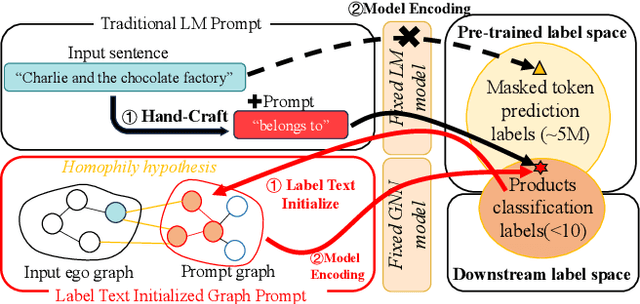
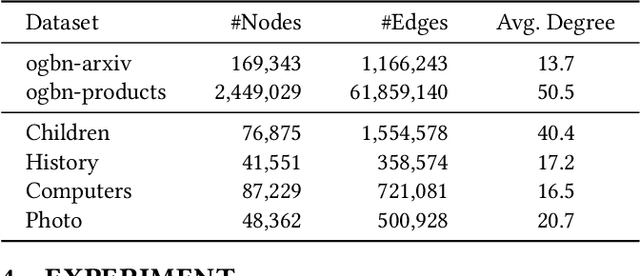
Abstract:The text-attributed graph (TAG) is one kind of important real-world graph-structured data with each node associated with raw texts. For TAGs, traditional few-shot node classification methods directly conduct training on the pre-processed node features and do not consider the raw texts. The performance is highly dependent on the choice of the feature pre-processing method. In this paper, we propose P2TAG, a framework designed for few-shot node classification on TAGs with graph pre-training and prompting. P2TAG first pre-trains the language model (LM) and graph neural network (GNN) on TAGs with self-supervised loss. To fully utilize the ability of language models, we adapt the masked language modeling objective for our framework. The pre-trained model is then used for the few-shot node classification with a mixed prompt method, which simultaneously considers both text and graph information. We conduct experiments on six real-world TAGs, including paper citation networks and product co-purchasing networks. Experimental results demonstrate that our proposed framework outperforms existing graph few-shot learning methods on these datasets with +18.98% ~ +35.98% improvements.
Approximating Probabilistic Inference in Statistical EL with Knowledge Graph Embeddings
Jul 16, 2024Abstract:Statistical information is ubiquitous but drawing valid conclusions from it is prohibitively hard. We explain how knowledge graph embeddings can be used to approximate probabilistic inference efficiently using the example of Statistical EL (SEL), a statistical extension of the lightweight Description Logic EL. We provide proofs for runtime and soundness guarantees, and empirically evaluate the runtime and approximation quality of our approach.
 Add to Chrome
Add to Chrome Add to Firefox
Add to Firefox Add to Edge
Add to Edge